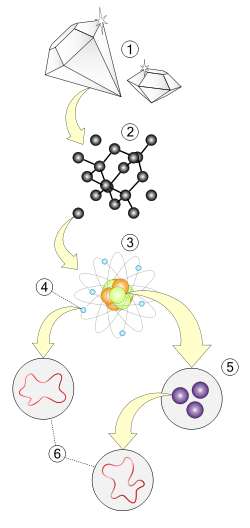 |
| Levels of magnification: 1. Macroscopic level: Matter 2. Molecular level 3. Atomic level: Protons, neutrons, and electrons 4. Subatomic level: Electron 5. Subatomic level: Quarks 6. String level kuva wikimedia |
Wikipediassa on kansantajuinen johdanto maailmankaikkeuden olemuksen pohdintaan otsikolla Introduction to M-theory, joka on ohessa kokonaisuudessaan..Analysoin artikkelia tuttuun tapaan lisäämällä tejksiin merkintöjä, kappalejakoa ym. muuttamatta itse sisältöä.
Miksi kokonaisuudessaan?
Koska huipputieteen tärkeän teeman esittely päättyy aidosti teologiseen teemaan, Suuri Suunnitelma!
M-theory
In the early years of the 20th century, the atom – long believed to be the smallest building-block of matter – was proven to consist of even smaller components called protons, neutrons and electrons, which are known as subatomic particles. Beginning in the 1960s, other subatomic particles were discovered. In the 1970s, it was discovered that protons and neutrons (and other hadrons) are themselves made up of smaller particles called quarks. Quantum theory is the set of rules that describes the interactions of these particles.
In the 1980s, a new mathematical model of theoretical physics called string theory emerged.
- It showed how all the particles, and all of the forms of energy in the universe, could be constructed by hypothetical one-dimensional "strings", infinitesimal building-blocks that have only the dimension of length, but not height nor width.
- Further, string theory suggested that the universe is made up of multiple dimensions.
Height, width, and length constitute three-dimensional space, and time gives a total of four observable dimensions; however, string theories supported the possibility of ten dimensions – the remaining six of which we cannot detect directly. This was later increased to 11 dimensions based on various interpretations of the 10-dimensional theory that led to five partial theories as described below. Super-gravity theory also played a significant part in establishing the necessity of the 11th dimension.
These "strings" vibrate in multiple dimensions, and depending on how they vibrate, they might be seen in three-dimensional space as matter, light, or gravity. It is the vibration of the string which determines whether it appears to be matter or energy, and every form of matter or energy is the result of the vibration of strings.
String theory, as mentioned above, ran into a problem: another version of the equations was discovered, then another, and then another. Eventually, there were five major string theories. The main differences between each theory were principally the number of dimensions in which the strings developed, and their characteristics (some were open loops, some were closed loops, etc.). Furthermore, all these theories appeared to be correct. Scientists were not comfortable with five seemingly contradictory sets of equations to describe the same thing.
In 1994, Edward Witten of the Institute for Advanced Study and other researchers suggested that the five different versions of string theory might be describing the same thing seen from different perspectives. They proposed a unifying theory called "M-theory", in which the "M" is not specifically defined, but is generally understood to stand for "membrane". The words "matrix", "master", "mother", "monster", "mystery", "magic" have also been claimed.
M-theory brought all of the string theories together. It did this by asserting that strings are really one-dimensional slices of a two-dimensional membrane vibrating in 11-dimensional space.
Status
M-theory is not complete, but the underlying structure of the mathematics has been established and is in agreement with all the string theories. Furthermore, it has passed many tests of internal mathematical consistency.
Some cosmologists are drawn to M-theory because of its mathematical elegance and relative simplicity. Physicist and author Michio Kaku has remarked that M-theory may present us with a "Theory of Everything" which is so concise that its underlying formula would fit on a T-shirt. Stephen Hawking originally believed that M-theory may be the ultimate theory but later suggested that the search for understanding of mathematics and physics will never be complete.
Hawking and Leonard Mlodinow, in the popular-science book The Grand Design, take a philosophical position to support a view of the universe as a multiverse, and define it in the book as model-dependent realism which along with a sum-over-histories approach (see Path integral formulation of Quantum mechanics) to the universe as a whole, is used to claim that M-theory is the only candidate for a complete theory of the universe.
Ei kommentteja:
Lähetä kommentti